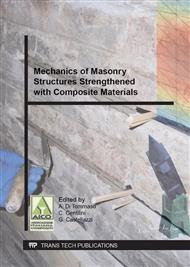p.291
p.299
p.307
p.313
p.322
p.330
p.338
p.346
p.354
Influence of Sample Thickness and Capping on Characterization of Bedding Mortars from Historic Masonries by Double Punch Test (DPT)
Abstract:
For determination of compressive strength of bedding mortar used in historic masonries, a promising moderately-destructive technique is double punch test (DPT). DPT consists of loading prismatic samples of mortar (about 4×4×1 cm3) by means of two circular steel platens (typically 2 cm diameter) and then calculating mortar compressive strength as the ratio of the failure load to the cross section of the circular platens. In this study, the influence of mortar sample thickness and mortar sample capping on the reliability of results obtained by DPT was systematically investigated. The influence of sample thickness was assessed by comparing DPT results obtained for samples with 5, 10, 15 and 20 mm thickness with compressive strength determined by testing reference 4 cm-side cubes. Different mortars were considered (cement, lime-cement, natural hydraulic lime), in order to investigate a wide range of mortar mechanical characteristics. The influence of surface capping was evaluated on a lime-cement mortar by comparing compressive strength determined on reference cubes with strength obtained by DPT on proper samples, without capping and after capping with rubber, gypsum and cement. The results of the study indicate that sample thickness substantially influences mortar compressive strength determined by DPT, which may vary by up to three times depending on sample thickness. A good estimation of the actual mortar compressive strength was obtained when samples with thickness similar to the loading platens diameter were tested, which suggests that choosing the size of the loading platens for DPT based on the thickness of mortar joints under investigation may be an effective way for obtaining reliable estimations. As for the influence of surface capping, in those cases where no mortar sample regularization is possible, because of the poor quality of the mortar, the results of the study indicate that sample capping actually seems necessary in order to avoid significant underestimations of mortar compressive strength. Considering the higher practicality offered by gypsum with respect to rapid-setting cement for surface capping, the use of gypsum seems preferable.
Info:
Periodical:
Pages:
322-329
Citation:
Online since:
September 2014
Authors:
Price:
Сopyright:
© 2015 Trans Tech Publications Ltd. All Rights Reserved
Share:
Citation:


